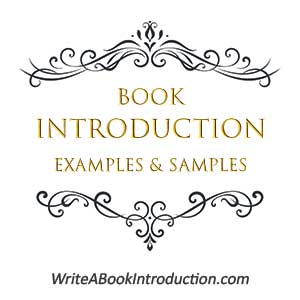Book Introduction Examples, Samples & Analysis
 This article featuring book introduction examples and samples with analysis draws from various genres to illustrate how introductions are crafted to engage readers and serve as a roadmap for the rest of the book. You’ll discover why some book introductions are effective, and what the best book introduction examples and samples have in common. This article is part of a series about how to write a book introduction, written by a former literary agent who’s helped 400+ authors get literary agents and/or traditional publishers.
This article featuring book introduction examples and samples with analysis draws from various genres to illustrate how introductions are crafted to engage readers and serve as a roadmap for the rest of the book. You’ll discover why some book introductions are effective, and what the best book introduction examples and samples have in common. This article is part of a series about how to write a book introduction, written by a former literary agent who’s helped 400+ authors get literary agents and/or traditional publishers.
The Best Book Introductions
Great book introduction examples include James Clear’s Atomic Habits, starting with a personal story to highlight the power of habits, and Michelle Obama’s Becoming, reflecting on identity to connect emotionally. Simon Sinek’s Start with Why uses a bold question to engage readers. Each hooks attention, defines purpose, and previews content.
Examples of Great Book Introductions
Whether you’re writing nonfiction, memoir, or even fiction that requires some context, studying successful book introductions can inspire and guide your own.
1. Atomic Habits by James Clear (Nonfiction)
- Hook: Clear opens with a gripping personal anecdote about a severe baseball injury that changed his life.
- Relevance: He connects his personal experience to the broader theme of habits and their transformative power.
- Credibility: The story establishes his authority as someone who has applied these strategies to overcome challenges.
- Roadmap: He promises actionable advice for building better habits and breaking bad ones.
Why It Works: This introduction is relatable, engaging, and directly tied to the book’s purpose. It hooks readers by showing them how habits can shape their lives
2. Becoming by Michelle Obama (Memoir)
- Hook: Obama reflects on her identity, stating, “I’ve been a lawyer, a vice president at a hospital, and the First Lady of the United States. I’m also a mother, a daughter, and, at times, a very ordinary person.”
- Relevance: She invites readers to explore her journey of self-discovery and transformation.
- Credibility: Her prominence and authenticity establish her as a voice worth listening to.
- Roadmap: She hints at the themes of resilience, relationships, and navigating public life.
Why It Works: The introduction’s reflective and personal tone immediately connects with readers, making them eager to learn more about her story
3. Sapiens: A Brief History of Humankind by Yuval Noah Harari (Nonfiction)
- Hook: Harari begins with a thought-provoking statement: “About 13.5 billion years ago, matter, energy, time, and space came into being.”
- Relevance: He outlines the sweeping scope of his book, exploring humanity’s origins and evolution.
- Credibility: As a historian and researcher, Harari’s authority is clear.
- Roadmap: He provides a brief overview of the book’s structure, explaining how it will explore humanity’s past and future.
Why It Works: The ambitious scope of the introduction intrigues readers, while the concise roadmap clarifies what to expect
4. The Subtle Art of Not Giving a F*ck by Mark Manson (Self-Help)*
- Hook: Manson begins with a bold statement: “This book will not teach you how to gain or achieve, but rather how to lose and let go.”
- Relevance: He challenges conventional self-help advice, positioning his book as a refreshing alternative.
- Credibility: His candid, relatable tone establishes trust with readers seeking unconventional wisdom.
- Roadmap: He introduces the concept of prioritizing what truly matters in life and how the book will guide readers through this process.
Why It Works: The irreverent and direct tone sets the book apart and appeals to readers tired of traditional self-help rhetoric
5. The 5 Love Languages by Gary Chapman (Nonfiction/Relationships)
- Hook: Chapman opens with a relatable story about a couple struggling to connect despite their love for each other.
- Relevance: He introduces the idea that understanding love languages can transform relationships.
- Credibility: As a counselor, Chapman’s experience lends authority to his advice.
- Roadmap: He outlines the five love languages and explains how the book will help readers apply them.
Why It Works: The relatable scenario immediately resonates with readers, while the promise of actionable solutions keeps them engaged
6. Educated by Tara Westover (Memoir)
- Hook: Westover vividly describes her isolated childhood in rural Idaho, where she was raised by survivalist parents.
- Relevance: She hints at the tension between her upbringing and her eventual pursuit of education.
- Credibility: Her deeply personal story establishes her unique perspective and voice.
- Roadmap: She sets the stage for the memoir’s exploration of family, identity, and transformation.
Why It Works: The vivid descriptions and emotional depth immediately draw readers into her world
7. The Lean Startup by Eric Ries (Business)
- Hook: Ries begins with a compelling scenario: why traditional business practices fail in modern, fast-paced industries.
- Relevance: He introduces the concept of the lean startup as a solution to these challenges.
- Credibility: His experience as an entrepreneur and innovator lends authority.
- Roadmap: He outlines the principles of the lean startup and how they will be explored in the book.
Why It Works: The introduction is clear, relevant, and immediately useful for entrepreneurs.
Key Takeaways from These Examples
- Start Strong:
- Use a bold statement, anecdote, or thought-provoking question to immediately capture attention.
- Make It Relatable:
- Connect with readers by addressing their needs, challenges, or curiosities.
- Keep It Focused:
- Avoid overwhelming readers with too much information; stick to the main purpose and themes.
- Provide Value:
- Clearly explain how the book will help or resonate with the reader.
Book Introduction Samples and Analysis
Listed below are book introduction samples for various genres, along with insights into why they would be effective. Let the real-life book introduction examples above, and these hypothetical examples, inform and inspire your process writing a book introduction.
1. Nonfiction: Self-Help
Sample from a Hypothetical Book: The Path to Productivity
“Have you ever felt like there just aren’t enough hours in the day? Like no matter how hard you work, your to-do list only grows longer? I felt the same way—until I discovered a method that changed everything.”
- Analysis:
- Hook: Opens with a relatable question that immediately connects with readers who struggle with productivity.
- Relevance: Highlights a common pain point and promises a solution.
- Tone: Conversational and approachable, making it easy for readers to engage.
- Effectiveness: This introduction makes readers feel understood and curious about the method being promised.
2. Memoir
Sample from a Hypothetical Book: Climbing My Own Everest
“The first time I stood at the base of Mount Everest, I was 22, broke, and carrying more self-doubt than supplies. Climbing that mountain felt impossible, but the real challenge lay within myself.”
- Analysis:
- Hook: Uses vivid imagery and personal struggle to draw readers in.
- Relevance: Introduces both the physical and emotional challenges of the story.
- Tone: Reflective and personal, establishing a deep connection with the audience.
- Effectiveness: By framing the mountain as both literal and metaphorical, the introduction hints at themes of growth and resilience.
3. Fiction
Sample from a Hypothetical Book: The Shadow’s Edge
“In the city of Nocturne, the shadows have a life of their own. Most people avoid the alleyways after dark, but not me—I’m the one they call when the darkness takes something it shouldn’t.”
- Analysis:
- Hook: Intriguing imagery and a unique premise immediately pique curiosity.
- Relevance: Sets the tone for a dark, mysterious narrative.
- Tone: Bold and immersive, reflecting the genre’s style.
- Effectiveness: The introduction establishes the setting and stakes while leaving readers eager to know more.
4. Business/Professional
Sample from a Hypothetical Book: Scaling Smart: The Art of Growing Your Startup
“Every entrepreneur dreams of scaling their business. But what if scaling too quickly becomes your downfall? In this book, I’ll show you how to scale sustainably, avoiding the pitfalls that many startups face.”
- Analysis:
- Hook: Opens with a universally shared aspiration and a cautionary statement.
- Relevance: Directly addresses the reader’s challenges and goals.
- Tone: Authoritative yet accessible, appealing to professional readers.
- Effectiveness: The introduction establishes credibility while setting up practical solutions for readers.
5. Academic/Technical
Sample from a Hypothetical Book: The Future of Artificial Intelligence
“Artificial intelligence isn’t coming—it’s already here. From chatbots to self-driving cars, AI is reshaping industries and societies. But what does this mean for our future? This book explores the ethical, economic, and social implications of living in an AI-driven world.”
- Analysis:
- Hook: Presents a bold statement about the immediacy of AI’s impact.
- Relevance: Frames the topic as urgent and essential for readers to understand.
- Tone: Analytical and informative, appealing to a knowledgeable audience.
- Effectiveness: Balances the technical and human aspects of the topic, making it engaging for both experts and laypeople.
6. Inspirational
Sample from a Hypothetical Book: From Doubt to Triumph
“Doubt is a powerful thing. It whispers that you’re not good enough, that success is for others. I know this because doubt nearly kept me from writing this book. But what if we could turn doubt into a driving force for success?”
- Analysis:
- Hook: Uses an emotional and relatable statement to engage readers.
- Relevance: Directly addresses the reader’s struggles with self-doubt.
- Tone: Encouraging and motivational, inviting readers to embark on a transformative journey.
- Effectiveness: The introduction is relatable and empowering, drawing readers in with the promise of growth.
What Do Most Book Introductions Have in Common?
- A Hook: Grabs the reader’s attention immediately.
- Relevance and Relatability: Addresses a common concern, need, or curiosity. Explains why the book matters and how it addresses the reader’s needs or interests.
- Clarity: Clearly communicates the book’s purpose and value.
- Engagement: Uses storytelling, questions, or bold statements to capture attention.
- Tone: Matches the genre and audience expectations.
- Brevity: Gets to the point quickly while still providing enough context to intrigue.
- Credibility: Establishes the author’s authority or personal connection to the subject.
- A Roadmap: Provides a preview of what the book covers.
Conclusion – Book Introduction Examples
A book introduction is your opportunity to make a lasting first impression and convince readers to keep going. Whether you’re crafting a thought-provoking narrative, sharing actionable insights, or taking readers on a personal journey, the book introduction samples and examples above illustrate the power of a well-structured and engaging introduction. By incorporating a strong hook, clear relevance, and a roadmap, you can create an introduction that captivates and inspires your audience.
Now that you’ve read “Book Introduction Examples and Samples” click here to make sure you’ve seen everything else in our Guide to Writing Book Introductions.


 This guide about
This guide about 